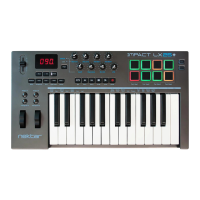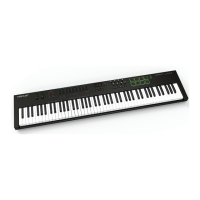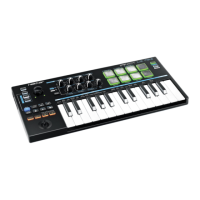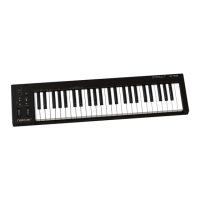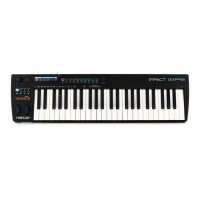Do you have a question about the Nektar Impact LX49 and is the answer not in the manual?
| Number of Keys | 49 |
|---|---|
| Aftertouch | No |
| Transport Controls | Yes |
| Type | MIDI Keyboard Controller |
| Pads | 8 |
| Faders | 9 |
| MIDI I/O | Out |
| OS Compatibility | Windows, macOS |
| Power | USB bus power |
| Connectivity | USB, MIDI |
| Pedal Inputs | 1 x 1/4" (sustain) |
Lists the items included in the Impact LX product box.
Details the key features and specifications of the Impact LX controller.
Outlines the hardware and software requirements for using the Impact LX.
Explains how to connect and power the Impact LX keyboard.
Guides on setting up Nektar DAW integration software.
Details the benefits and process of registering for product updates.
Steps for installing the Studio One Artist software and Impact LX integration.
Notes for users of Studio One Producer or Professional versions.
Checks to ensure Studio One Artist and Impact LX are functioning correctly.
Explains the function of the transport buttons on the Impact LX.
How to view and hide the Studio One mixer window.
Controls for channel volume and pan using faders and pots.
Using fader buttons for mute and solo functions.
How to control subsequent groups of mixer channels.
Controlling the master volume fader in Studio One.
Initial configuration for controlling instruments with Impact LX.
How to display and hide the instrument GUI window.
Navigating patches and controlling instrument parameters.
How to modify plug-in mappings within Studio One.
Moving between plug-ins in an instrument track's insert chain.
Assigning sounds to pads using the Pad Learn function.
Using faders and pots to control drum sound volumes.
Adjusting the keyboard octave up or down.
Reassigning Octave buttons for MIDI functions.
Reassigning Transpose buttons for MIDI functions.
Enabling and configuring the layer function for split keyboard setups.
Enabling and configuring the split function for keyboard zones.
How to define the keyboard split point.
Adjusting octave and MIDI channel via transpose buttons.
Transmitting program change messages for layer/split.
Description and use of pitch bend and modulation wheels.
Connecting and using a foot switch pedal.
Managing wheel and switch functions for zones.
Overview of presets for controlling MIDI software.
Muting MIDI output and activating secondary functions.
Sending current control status for recall or experimentation.
Feature to avoid parameter jumping between presets.
Assigning notes to pads via keyboard input.
Accessing and navigating the setup menus.
Loading and saving different pad setups.
Changing pad note assignments.
Using pads as MIDI switch buttons.
Selecting velocity response for pads.
Changing the MIDI CC number for controls.
Assigning controls to specific or global MIDI channels.
Setting Data 1 and Data 2 for specific controller assignments.
Instructions for saving custom presets and pad maps.
Alternative method for loading presets.
Setting the global MIDI channel for the keyboard.
Configuring MIDI channels for layer/split zones.
Selecting keyboard velocity response curves.
Sending all notes off and controller reset messages.
Sending specific MIDI program change messages.
Sending program messages for layer/split zones.
Sending MIDI Bank LSB and MSB messages.
Sending bank messages for layer/split zones.
Backing up controller settings via MIDI sysex.
Configuring virtual USB port settings.
Assigning virtual ports for layer/split.



